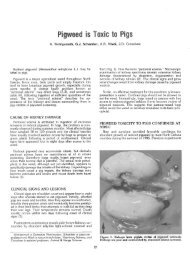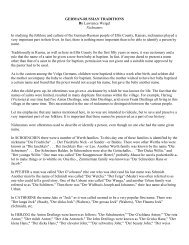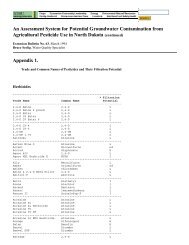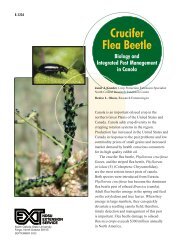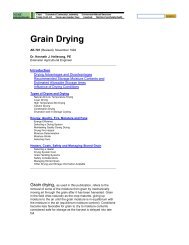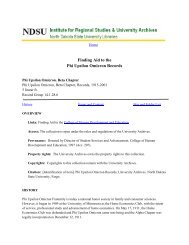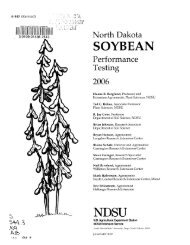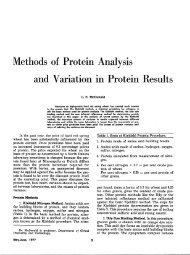Biology and Management of Biennial Wormwood
Biology and Management of Biennial Wormwood
Biology and Management of Biennial Wormwood
You also want an ePaper? Increase the reach of your titles
YUMPU automatically turns print PDFs into web optimized ePapers that Google loves.
<strong>Biology</strong> <strong>and</strong><strong>Management</strong> <strong>of</strong><strong>Biennial</strong> <strong>Wormwood</strong><strong>Biennial</strong> wormwood is an aggressive <strong>and</strong> prolific seed-producing plant thathas become a problem mainly in soybean <strong>and</strong> dry edible bean productionareas <strong>of</strong> Minnesota, North Dakota <strong>and</strong> South Dakota. <strong>Biennial</strong> wormwood,as its name infers, was primarily biennial when the species first was classified,but weedy cropl<strong>and</strong> biotypes <strong>of</strong> biennial wormwood are annual plants. Manyfactors, such as season-long emergence, prevalence in moist environments,adaptation to all tillage systems, tolerance to commonly used soil-applied<strong>and</strong> postemergence herbicides, <strong>and</strong> misidentification <strong>of</strong> biennial wormwoodas common ragweed, contribute to increased biennial wormwoodinfestations. Some herbicides used to control common ragweed do notcontrol biennial wormwood.Figure 1. <strong>Biennial</strong> wormwood seedlings approximately seven days afteremergence.2Figure 2. <strong>Biennial</strong> wormwood seedling approximately three to four weeks afteremergence.
<strong>Biology</strong> <strong>and</strong> <strong>Management</strong> <strong>of</strong> <strong>Biennial</strong> <strong>Wormwood</strong>Identifi cation<strong>Biennial</strong> wormwood is a small-seeded plant that behaves like an annualspecies. <strong>Biennial</strong> wormwood stems arise from a tap root, are hairless <strong>and</strong><strong>of</strong>ten are tinged red. The leaves are hairless <strong>and</strong> have toothed margins. Plantstypically grow 3 to 7 feet (1 to 2 meters) tall with a woody stem averaging1 to 2 inches (3 to 5 centimeters) in diameter. <strong>Biennial</strong> wormwood flowersconsist <strong>of</strong> heads in clusters arranged in a spikelike form. <strong>Biennial</strong> wormwoodis a prolific weed, producing approximately 1 million seeds per plant(Stevens 1932). Mahoney <strong>and</strong> Kegode (2004) later estimated that a singlebiennial wormwood plant produced 400,000 seeds. Stevens’ estimate <strong>of</strong> seedproduction possibly was from a biennial plant, whereas the later estimate wasfrom an annual plant.Figure 3. Bolting biennial wormwood plant.Figure 4. Photo showing spikelike flower head <strong>of</strong> a mature biennialwormwood plant in early September (left) <strong>and</strong> mid-October (right) atFargo, N.D.3
Glyphosate, Weeds, <strong>and</strong> CropsOccurrence <strong>and</strong> Distribution<strong>Biennial</strong> wormwood is native to North America, specifically the RockyMountains <strong>and</strong> Sierra Nevada <strong>and</strong> Cascade ranges <strong>of</strong> the northwesternUnited States <strong>and</strong> western Canada.<strong>Biennial</strong> wormwood historically was classified as a noncropl<strong>and</strong> weed <strong>and</strong>,as such, did not receive much attention until cropl<strong>and</strong> infestations began torise noticeably. Surveys conducted in the late 1970s did not identify biennialwormwood in any field that was sampled (Dexter et al. 1981). However,in a 1997 survey <strong>of</strong> South Dakota, biennial wormwood was found in 92percent <strong>of</strong> soybean fields (Snyder 1997), whereas in a 2000 survey, biennialwormwood was present in 3.2 percent <strong>of</strong> 663 North Dakota fields that weresampled (Zollinger et al. 2003). Similarly, biennial wormwood was not acommon problem in continuous cereal <strong>and</strong> cereal-legume fields in Manitoba,Canada, in 1993 but was detected in 1994 (Ominski et al. 1999).<strong>Biennial</strong> wormwood is found throughout the United States except theSouth (Figure 5). Perhaps annual <strong>and</strong> biennial types <strong>of</strong> biennial wormwoodcoexisted in the region <strong>of</strong> its origin, but primary use <strong>of</strong> the adjective“biennial” infers that the biennial trait was predominant. The eastwardspread <strong>of</strong> biennial wormwood into agricultural areas may have resulted fromselection <strong>of</strong> the annual biotype; however, this aspect <strong>of</strong> biennial wormwoodhas yet to be investigated.Figure 5. Distribution <strong>of</strong> biennial wormwood in the United States in 2000.www.csdl.tamu.edu/FLORA/cgi/b98_map?genus=Artemisia&species=biennis(accessed Jan. 25, 2006)4
<strong>Biology</strong> <strong>and</strong> <strong>Management</strong> <strong>of</strong> <strong>Biennial</strong> <strong>Wormwood</strong>Seedling Emergence, Growth <strong>and</strong> DevelopmentSeedling emergence can occur during the entire crop growing seasonunder moist conditions <strong>and</strong> favorable environmental conditions.Characterization <strong>of</strong> emergence patterns in eastern North Dakota indicatedthat the weed began to emerge in late June or early July in corn, dry bean,soybean <strong>and</strong> sunflower (Kegode <strong>and</strong> Ciernia 2003). <strong>Biennial</strong> wormwoodgrows slowly after emergence, remaining as a rosette until midsummer, whenplants bolt <strong>and</strong> growth becomes rapid. <strong>Biennial</strong> wormwood <strong>of</strong>ten is confusedfor common ragweed (Figure 6).Figure 6. Comparison <strong>of</strong> biennial wormwood (right) <strong>and</strong> common ragweed(left) plants growing next to each other in the field.Distinguishing <strong>Biennial</strong> <strong>Wormwood</strong>from Common Ragweed<strong>Biennial</strong> wormwood can bedistinguished from commonragweed by a close examination<strong>of</strong> the leaves. <strong>Biennial</strong>wormwood leaves have sharpedges <strong>and</strong> are hairless, whereascommon ragweed leaves havesmooth <strong>and</strong> round edges <strong>and</strong>are hairy (Figure 7).Figure 7. Comparison <strong>of</strong> leaves <strong>of</strong> biennial wormwood (left)<strong>and</strong> common ragweed (right).5
Glyphosate, Weeds, <strong>and</strong> CropsInterference <strong>and</strong> Competition<strong>Biennial</strong> wormwood emergence depends on soil type:• In a silty clay soil, biennial wormwood emergence occurred in lateJune, compared with other common weed species, such as foxtail spp.,common lambsquarter <strong>and</strong> pigweed spp., all <strong>of</strong> which emerge in lateMay or early June (Figure 8).• In a s<strong>and</strong>y loam soil, biennial wormwood emergence occurred in lateApril (Fronning <strong>and</strong> Kegode 2004)• In a loam soil, biennial wormwood emergence occurred in late May(Fronning <strong>and</strong> Kegode 2004).Figure 8. Cumulative emergence percentages for biennial wormwood, foxtail spp.(green <strong>and</strong> yellow), common lambsquarters <strong>and</strong> pigweed spp. (redroot <strong>and</strong> Powellamaranth) in soybean at Fargo, N.D. (silty clay soil) in 2003.Upon emergence, biennial wormwood seedlings grow slowly <strong>and</strong> occuras rosettes for much <strong>of</strong> the early part <strong>of</strong> the growing season (Mahoney <strong>and</strong>Kegode 2004). In late July, when day length is declining, biennial wormwoodplants bolt as they prepare to reproduce <strong>and</strong> appear above the canopy <strong>of</strong>crops such as soybean (Figures 4 <strong>and</strong> 9).6Figure 9. Unharvested section <strong>of</strong> a soybean field due to a biennial wormwoodinfestation.
<strong>Biology</strong> <strong>and</strong> <strong>Management</strong> <strong>of</strong> <strong>Biennial</strong> <strong>Wormwood</strong><strong>Biennial</strong> wormwood competes more aggressively for resources thansoybean, <strong>and</strong> season-long competition from nine biennial wormwood plants/yard 2 (10 plants/meter 2 ) can reduce soybean yield by 44 percent (Nelson2001; Nelson <strong>and</strong> Kegode 2006). Further reductions in yield can occur asa result <strong>of</strong> harvesting inefficiency due to skips in soybean fields becausefarmers avoid large infestations <strong>of</strong> biennial wormwood (Figure 9).Increased PrevalenceMisidentifying biennial wormwood as common ragweed; use <strong>of</strong> ineffectiveherbicides; multiple flushes during the summer; preference to moist, wetconditions; <strong>and</strong> survivability under most tillage systems have caused biennialwormwood infestations to increase.Herbicide Tolerance<strong>Biennial</strong> wormwood has natural tolerance to many soil-applied <strong>and</strong>postemergence broadleaf herbicides. Some herbicides include:ALS herbicidesDintroanilinesHPPD InhibitorsPPO InhibitorsAcetamidesImidazolinone (Imi) herbicides (Beyond®, Pursuit®<strong>and</strong> Raptor®)Sulfonylurea (SU) herbicides (Ally®, Accent®,Express®, Affinity®, Harmony GT®, Resolve®, others)Triazolpyrimidines (TPS) herbicides (FirstRate®)Sulfonylaminocarbonyltriazolinone (SACT)herbicides (Everest® <strong>and</strong> Olympus®)Prowl®, Sonalan®, Treflan® <strong>and</strong> genericsCallisto® <strong>and</strong> Impact®Aim®, Cobra®, Flexstar®, Reflex® <strong>and</strong> Ultra Blazer®Dual®, Define®, Harness®, Surpass®, Lasso®,Outlook® <strong>and</strong> genericsOther herbicides that do not control biennial wormwood includebromoxynil. Starane® (fluoxypyr) is a growth regulator-type herbicide suchas 2,4-D, MCPA <strong>and</strong> clopyralid but does not control biennial wormwood.7
Glyphosate, Weeds, <strong>and</strong> CropsControlWhere possible, preemergence followed by postemergence herbicides isthe most effective strategy in biennial wormwood control (Kegode 2000,Fronning <strong>and</strong> Kegode 2004b).PreemergenceBecause <strong>of</strong> season-long emergence <strong>of</strong> biennial wormwood, soil-appliedherbicides with long residual are needed to provide the best management(Fronning <strong>and</strong> Kegode 2004a). Active ingredients <strong>of</strong> soil-applied herbicidesthat provide greater than 80 percent control <strong>of</strong> biennial wormwoodinclude flumioxazin (Valor®), isoxaflutole (Balance Pro®), metribuzin <strong>and</strong>sulfentrazone (Spartan®). <strong>Biennial</strong> wormwood is tolerant <strong>of</strong> most ALSherbicide with the exception <strong>of</strong> flumetsulam (Python®). Flumetsulamapplied pre-emergence will control biennial wormwood.PostemergencePostemergence herbicides must be applied to seedlings that are less than3 inches (8 centimeters) in height (Fronning <strong>and</strong> Kegode 2004b). <strong>Biennial</strong>wormwood becomes very tolerant to postemergence herbicides when plantsare greater than 3 inches tall. Active ingredients <strong>of</strong> postemergence herbicidesthat provide greater than 80 percent control <strong>of</strong> biennial wormwood includeatrazine, bentazon, clopyralid, dicamba, glufosinate, glyphosate, MCPA <strong>and</strong>2,4-D.8RateHerbicide (product/A) Wheat Corn Soybeanatrazine 0.38-0.5 lb ai CBalance Pro® 1.5-3 fl. oz. CBasagran® 1 pt. fb 1 pt. S/C S/CBronate® 2 pt. S/CCurtail®/Curtail M® 2-2.67 pt. Cdicamba 2-4 fl. oz. S S/CExtreme® (RR) 2.25 pt. S/Cglyphosate 0.75 lb. ai S/C S/C S/CHornet® 2-5 oz. CLiberty® (Liberty Link) 28-34 fl. oz. C CMCPA 1 pt. S/CPython® 0.8-1.33 oz. C CSencor® (PRE) 0.25-0.33 lb. CSpartan® 3-8 fl. oz. S/CStatus® 4-5 oz. S/CStinger® 0.25-0.66 pt. CValor® 2-3 oz. S/CWideMatch® 1-1.33 pt. C2,4-D 0.5-1 pt. S/CS = suppression, C = control
<strong>Biology</strong> <strong>and</strong> <strong>Management</strong> <strong>of</strong> <strong>Biennial</strong> <strong>Wormwood</strong><strong>Biennial</strong> <strong>Wormwood</strong> Control inOther CropsDrybean <strong>and</strong> LentilApply Basagran® at 1 pint per acre (pt/A) before biennial wormwoodseedlings are 2 to 3 inches tall, followed by another application <strong>of</strong> Basagran®at 1 pt/A no more than 14 days later. This sequential application results inexcellent control <strong>of</strong> biennial wormwood. (Figure 10).Dry pea <strong>and</strong> ChickpeaApply Spartan® preemergence followed by post-applied Basagran®. Asequential postemergence Basagran® application can be used as described inthe Drybean <strong>and</strong> Lentil section.Sunflower – Conventional <strong>and</strong> ClearfieldPreemergence Spartan® may control or reduce biennial wormwoodinfestations.FlaxApply Spartan® preemergence followed by post-applied MCPA or Bronate®.Canola <strong>and</strong> SugarbeetApply Stinger® postemergence.PotatoPreemergence Valor®/Chateau® can control or reduce biennial wormwoodinfestations.Roundup Ready Alfalfa, Canola, Corn <strong>and</strong> SoybeanGlyphosate can control emerged biennial wormwood plants. Use <strong>of</strong> othereffective residual herbicides may be needed for season-long control. See cropsections above. Glyphosate split-applied also provides excellent control <strong>of</strong>biennial wormwood.Late Postemergence Control <strong>of</strong> <strong>Biennial</strong> <strong>Wormwood</strong><strong>Biennial</strong> wormwood can go undetected in crop fields until the seedlingsare too large to be controlled effectively. Evaluation <strong>of</strong> Basagran®, Liberty®<strong>and</strong> glyphosate in greenhouse studies for efficacy <strong>of</strong> control <strong>of</strong> various sizesUntreatedBasagran at 1 pt /A (0.5 lb ai /A)Figure 10. Control <strong>of</strong>biennial wormwoodwith Basagran®applied once <strong>and</strong> twice(split-application).Basagran at 2 pt /A (1 lb ai /A) Basagran split-applied at 1 pt /Afollowed by 1 pt /A (0.5 / 0.5 lb ai /A)9
Glyphosate, Weeds, <strong>and</strong> Crops<strong>of</strong> biennial wormwood seedlings ranging from 2 to 19 inches (6 to 47centimeters) indicated that:• Glyphosate applied at 0.75 <strong>and</strong> 1.5 pounds <strong>of</strong> acid equivalent per acre(lb ae/A) (1 to 2 quarts <strong>of</strong> 3 lb ae /gallon formulation) provided greaterthan 92 percent control <strong>of</strong> all sizes <strong>of</strong> biennial wormwood seedlings.• Basagran® applied at 0.5 <strong>and</strong> 1 pound <strong>of</strong> active ingredient per acre (lbai/A) (1 to 2 pints/acre) provided at least 80 percent control <strong>of</strong> biennialwormwood seedlings up to 8 inches (20 centimeters) tall.• Liberty® applied in greenhouse conditions generally provided poorcontrol regardless <strong>of</strong> biennial wormwood seedling size or herbiciderate (Kegode <strong>and</strong> Fronning 2005). However, several postemergenceevaluations <strong>of</strong> Liberty applied in field conditions show excellentcontrol.Conclusion<strong>Biennial</strong> wormwood is an established weed <strong>of</strong> the northern Great Plains,particularly in soybean, dry bean <strong>and</strong> sunflower. Because emergence isindeterminate, the best herbicidal control is from split applications <strong>of</strong> eitherUntreatedStarane at 0.67 pt /A (0.125 lb ai /A)Figure 11. Control<strong>of</strong> biennialwormwood withStarane®, Stinger®<strong>and</strong> Clarity®.Stinger at 0.5 pt /A (0.188 lb ai /A)Clarity at 0.5 pt /A (0.25 lb ai /A)UntreatedRoundup UltraMax II at 1 pt/A(0.56 lb ae /A)Figure 12. Control <strong>of</strong>biennial wormwoodwith RoundupUltraMax II®.10Roundup UltraMax II at 1.5 pt/A(0.84 lb ae /A)Roundup UltraMax II at 2 pt/A(1.12 lb ae /A)
The Glyphosate, Weeds, <strong>and</strong> Crops Series<strong>Biology</strong> <strong>and</strong><strong>Management</strong> <strong>of</strong><strong>Biennial</strong><strong>Wormwood</strong>Other Publications in this SeriesTo view other publications in theGlyphosate, Weeds, <strong>and</strong> Crops series, visit:www.glyphosateweedscrops.org/The NDSU Extension Service does not endorse commercial products or companies even thoughreference may be made to tradenames, trademarks or service names.This publication may be copied for noncommercial, educational purposes in its entirety with no changes.Requests to use any portion <strong>of</strong> the document (including text, graphics or photos) should be sent topermission@ndsuext.nodak.edu. Include exactly what is requested for use <strong>and</strong> how it will be used.For more information on this <strong>and</strong> other topics, see: www.ag.ndsu.eduCounty commissions, North Dakota State University <strong>and</strong> U.S. Department <strong>of</strong> Agriculture cooperating. Duane Hauck, director,Fargo, N.D. Distributed in furtherance <strong>of</strong> the acts <strong>of</strong> Congress <strong>of</strong> May 8 <strong>and</strong> June 30, 1914. We <strong>of</strong>fer our programs <strong>and</strong> facilitiesto all people regardless <strong>of</strong> race, color, national origin, religion, gender, disability, age, veteran’s status or sexual orientation; <strong>and</strong>are an equal opportunity institution. This publication will be made available in alternative formats for people with disabilitiesupon request, (701) 231-7881.3M-2-07



